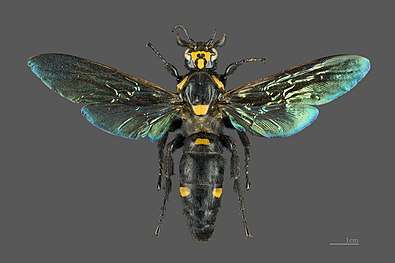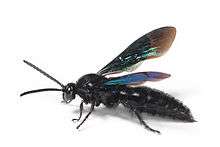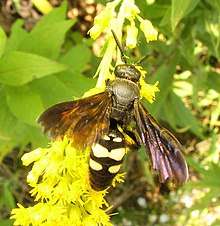Scoliidae
The Scoliidae, the scoliid wasps, are a family of about 560 species found worldwide. They tend to be black, often marked with yellow or orange, and their wing tips are distinctively corrugated. Males are more slender and elongated than females, with significantly longer antennae, but the sexual dimorphism is not as apparent as in the Tiphiidae.

| Scoliidae | |
|---|---|
 | |
| Black flower wasp (Austroscolia soror), Australia | |
| Scientific classification | |
| Kingdom: | Animalia |
| Phylum: | Arthropoda |
| Class: | Insecta |
| Order: | Hymenoptera |
| Infraorder: | Aculeata |
| Superfamily: | Scolioidea |
| Family: | Scoliidae Latreille, 1802 |
| Subfamilies | |
|
Scoliinae | |

Scoliid wasps are solitary parasitoids of scarab beetle larvae. Female scoliids burrow into the ground in search of these larvae and then use their sting to paralyze them. They will sometimes excavate a chamber and move the paralyzed beetle larva into it before depositing an egg. Scoliid wasps act as important biocontrol agents, as many of the beetles they parasitize are pests, including the Japanese beetle. Male scoliids patrol territories, ready to mate with females emerging from the ground. Adult wasps may be minor pollinators of some plants and can he found on many wildflowers in the late summer.
Scoliidae also has at least one species known to engage in pseudocopulation with an orchid. Flowers of the orchid Bipinnula penicillata in subtropical South America resemble females of Pygodasis bistrimaculata, tricking male wasps into attempting to mate and, in the process, provide pollination. Scoliids include some of the largest wasps in the world, with only the similarly large tarantula hawk wasps rivaling them in size.
Taxonomy
Scoliidae genera are classified as follows:[1][2][3]
Subfamily: Proscoliinae
- Proscolia Rasnitsyn 1977 [4]
Subfamily: Scoliinae
Tribe: Campsomerini
- Aelocampsomeris Bradley 1957
- Aureimeris Betrem, 1972
- Australelis Betrem, 1962
- Campsomeriella Betrem, 1941
- Campsomeris Lepeletier, 1838
- Cathimeris Betrem, 1972
- Charimeris Betrem, 1971
- Colpa Dufour, 1841
- Colpacampsomeris Betrem, 19671
- Crioscolia Bradley, 1951
- Dasyscolia Bradley, 1951
- Dielis Saussure & Sichel, 1864
- Extrameris Betrem, 1972
- Guigliana Betrem, 1967
- Laevicampsomeris Betrem, 1933
- Leomeris Betrem, 1972
- Lissocampsomeris Bradley, 1957
- Megacampsomeris Betrem, 1928
- Megameris Betrem, 1967
- Micromeriella Betrem, 1972
- Peltatimeris Betrem, 1972
- Phalerimeris Betrem, 1967
- Pseudotrielis Betrem, 1928
- Pygodasis Bradley, 1957
- Radumeris Betrem, 1962
- Rhabdotimeris Bradley, 1957
- Sericocampsomeris Betrem, 1941
- Sphenocampsomeris Bradley, 1957
- Stygocampsomeris Bradley, 1957
- Tenebromeris Betrem, 1963
- Trisciloa Gribodo, 1893
- Tristimeris Betrem, 1967
- Tubatimeris Betrem, 1972
- Tureimeris Betrem, 1972
- Xanthocampsomeris Bradley, 1957
Tribe: Scoliini
- Austroscolia Betrem, 1927
- Diliacos Saussure & Sichel, 1864
- Laeviscolia Betrem, 1928
- Liacos Guérin-Méneville, 1838
- Megascolia Betrem, 1928
- Microscolia Betrem, 1928
- Mutilloscolia Bradley, 1959
- Pyrrhoscolia Bradley, 1957
- Scolia Fabricius 1775
- Triscolia de Saussure 1863
North American species list
There are about 20 species in North America north of Mexico.[5] Species include:
- Campsomeriella annulata (Fabricius 1793) (introduced species, no established population)
- Micromeriella marginella (Klug 1810) (introduced species, no established population)
- Colpa octomaculata (Say 1823)
- Colpa pollenifera (Viereck 1906)
- Crioscolia alcione (Banks 1917)
- Crioscolia flammicoma (Bradley 1928)
- Dielis dorsata (Fabricius 1787)
- Dielis pilipes (Saussure 1858)
- Dielis plumipes (Drury 1770)
- Dielis tolteca (Saussure 1857)
- Dielis trifasciata (Fabricius 1793)
- Pygodasis ephippium (Say 1837)
- Pygodasis quadrimaculata (Fabricus 1775)
- Scolia bicincta (Fabricius 1775) – double-banded scoliid wasp
- Scolia dubia (Say 1837) – blue-winged wasp
- Scolia guttata (Burmeister 1853)
- Scolia mexicana (Saussure 1858)
- Scolia nobilitata (Fabricius 1805)
- Triscolia ardens (Smith 1855)
- Xanthocampsomeris completa (Rohwer 1927)
- Xanthocampsomeris fulvohirta (Cresson 1865)
- Xanthocampsomeris hesterae (Rohwer 1921)
- Xanthocampsomeris limosa (Burmeister 1853)
| Wikimedia Commons has media related to Scoliidae. |
References
- "Full list of Scoliidae and their Genus (German)" (PDF). Retrieved 2014-06-24.
- "Classification and checklist of Afrotropical mammoth wasps". Retrieved 2019-07-18.
- "BugGuide - Family Scoliidae". Retrieved 2019-07-18.
- "Fauna Europaea".
- "NOMINA INSECTA NEARCTICA" (PDF). Retrieved 2011-10-10.
First Confirmed Case of Pseudocopulation in Terrestrial Orchids of South America